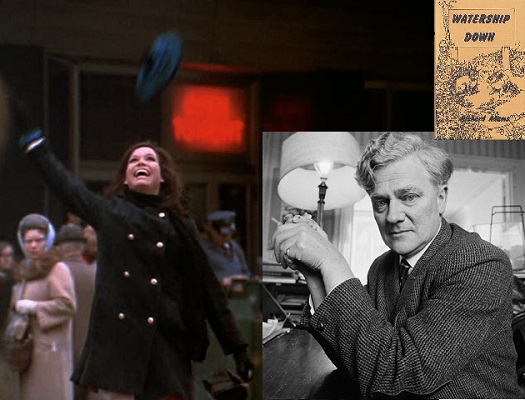
Richard Adams died on Christmas Eve last year. That will always be a fact of my life, that I got engaged to Alex on the night of the day that Richard Adams, author of my favorite book of all-time, Watership Down, passed away. I was sad, of course. Not sad enough for it to derail my planned proposal, or luminaria day, or anything like that. And not as sad as I wanted to be. Because, after all, the man was 96. It is sad to know that the world no longer contains a person who has done so much for you personally as to write your favorite book. But less sad to know that they got as much time as anyone would want here, and perhaps more.
Eighty is not ninety-six, certainly, and Mary Tyler Moore didn’t have quite the impact on my life that Richard Adams did. But I spent a lot of my teenage years watching Nick-at-Nite incessantly, hours at a time, and both The Dick Van Dyke Show and especially The Mary Tyler Moore Show were key features of the late-night network’s lineup at the time. I loved them both, but especially the latter, where MTM had been able to shed some of the sexist tropes of the DVD writers and really star on her own as a model of independence, talent, and humor. It’s not to say that the MTM writing was totally without sexism, but as people have observed the world over in the last 24 hours, Mary Tyler Moore was ahead of her time and a pioneer for feminism.
Of all the Nick-at-Nite shows I really liked (along with close second Get Smart, Dobie Gillis, Dick Van Dyke, Bob Newhart, Bewitched, I Dream of Jeannie, Taxi, and Cheers) I think I loved Mary Tyler Moore the most. Her show was fresh and funny and avoided a lot of traditional romantic arcs that one would expect from that kind of show. Mary Richards was not continually pining for one person in a will-they/won’t-they battle that where we all knew the ending on the second episode. She was independent, smart, and worked in journalism, but not as the flashy broadcaster you might expect for someone in her role. She was a producer, and one who can see the buffoonery of the pretty figurehead in the anchor role. She worked with a tough boss, an old-school journalist, and the insight into the world of the news and how it really gets made fascinated me. More than anything, Mary’s world felt real to me. Her effort to make it in the world of work, friendships, relationships, and what we now might call “adulting” resonated with my picture of what the future might look like. She, and the show, were eminently authentic.
Watching Mary Tyler Moore, growing up on the coming-of-adult-age story meant for a prior era, I found so much to emulate. I wanted to be like Mary. I wanted to be compassionate and emotional and independent and capable like she was. I wanted my life to look like hers. And not just because I wish I’d been my age in the sixties instead of the nineties.
I’ve probably seen every episode of the show at least twice. It’s in the pantheon with Gilmore Girls and Doctor Who and The Wire and Lost and probably a smattering of the other Nick-at-Nite selections listed above. I think of myself as someone who really doesn’t like TV, but I’ve honestly watched a ton of TV for someone in that category.
Richard Adams is not my favorite author of all time, any more than Mary Tyler Moore is my favorite actor. Adams’ other works are uneven, generally disappointing. He is one of those authors who possibly had only one truly great story to tell, his first, something crafted over years of oral storytelling in long car rides with his daughters. I tried to get into The Plague Dogs and couldn’t, largely because it was about dogs and not rabbits. (It prompts the question of whether I would have been deprived of the grand and life-changing allegory of Watership Down had it been about dogs instead.) I liked The Girl in the Swing, but it was a bit overly sensationalized. Even the sequel Tales from Watership Down, which I was so excited to hear of and read, rang hollow, felt a bit contrived, felt like an effort to tweak and/or cash in on the past, left me feeling pretty empty. None of this really cheapens Adams’ legacy for me, though. Just ask Harper Lee, whose only (until the cynically commercial effort to publish Go Set a Watchman) book stands atop the Blue Pyramid’s composite list of people’s top twenty-five books of all-time. You don’t need to write more than one book to change the world.
How do we mourn those who had a full long life? Is it okay to feel less sad? Having so recently experienced the sudden death of a 34-year-old, I can say that it feels different and it probably should. Of course, the other key difference there is that I knew Jon, while Richard and Mary only influenced my life as far-away strangers, through their art. As someone who hopes to be an influential artist, I can mourn this loss by proxy, while still recognizing that I would expect the sadness of people impacted only by art to be quite muted compared to those who actually know me in real life.
Perhaps a more apt comparison would be how I feel about Moore and Adams relative to, say, David Foster Wallace. They all impacted me from distance, but DFW, by his own choice, didn’t get the time he should have been allotted. Part of that loss, to be sure, is the pain of the books unwritten, the art unmade, the other things one could have enjoyed. And part of it, perhaps, is not being able to meet someone who influenced you so much. I never much carried the illusion that I could meet Mary Tyler Moore or Richard Adams someday. But DFW felt more accessible, gave me more time to get in a position where such a meeting would be more likely.
Which makes mourning all feel a little selfish, I guess. And stranger in light of my primary emotion at the loss of Adams and Moore being somehow sadder that I’m not more sad. But maybe being at peace with death, when it comes late in life and after it has been full, is okay. Maybe a little more acceptance is just what’s called for when the good die old.
Or maybe I should look to one of the most profound and powerful meditations on death I’ve ever read:
One chilly, blustery morning in March, I cannot tell exactly how many springs
later, Hazel was dozing and waking in his burrow. He had spent a good deal of
time there lately, for he felt the cold and could not seem to smell or run so well as
in days gone by. He had been dreaming in a confused way — something about rain
and elder bloom — when he woke to realize that there was a rabbit lying quietly
beside him — no doubt some young buck who had come to ask his advice. The
sentry in the run outside should not really have let him in without asking first.
Never mind, thought Hazel. He raised his head and said, “Do you want to talk to
me?”“Yes, that’s what I’ve come for,” replied the other. “You know me, don’t you?”
“Yes, of course,” said Hazel, hoping he would be able to remember his name in
a moment. Then he saw that in the darkness of the burrow the stranger’s ears
were shining with a faint silver light. “Yes, my lord,” he said, “Yes, I know you.”“You’ve been feeling tired,” said the stranger, “but I can do something about
that. I’ve come to ask whether you’d care to join my Owsla. We shall be glad to
have you and you’ll enjoy it. If you’re ready, we might go along now.”They went out past the young sentry, who paid the visitor no attention. The
sun was shining and in spite of the cold there were a few bucks and does at silflay,
keeping out of the wind as they nibbled the shoots of spring grass. It seemed to
Hazel that he would not be needing his body any more, so he left it lying on the
edge of the ditch, but stopped for a moment to watch his rabbits and to try to get
used to the extraordinary feeling that strength and speed were flowing
inexhaustibly out of him into their sleek young bodies and healthy senses.“You needn’t worry about them,” said his companion. “They’ll be all right —
and thousands like them. If you’ll come along, I’ll show you what I mean.”He reached the top of the bank in a single, powerful leap. Hazel followed; and
together they slipped away, running easily down through the wood, where the
first primroses were beginning to bloom.


